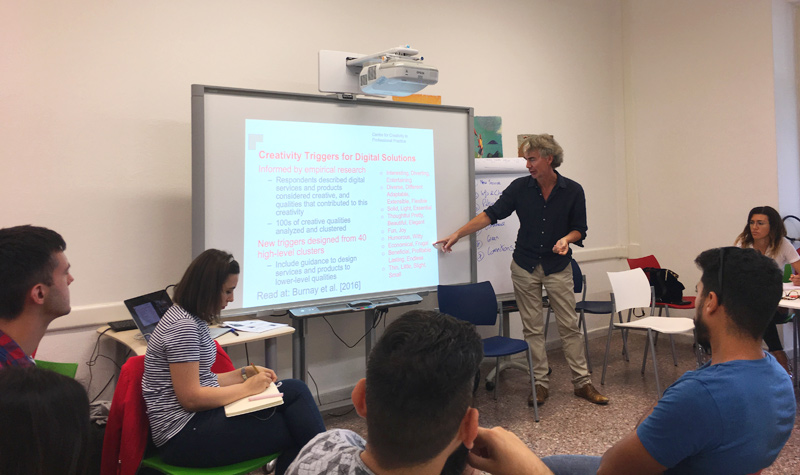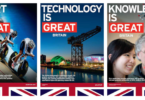Last June I had the pleasure to attend a very interesting workshop about Design Thinking organised by CREA – Unica in Cagliari, and held by Neil Maiden, Professor of Digital Creativity at the Cass Business School – City, University of London.
During this two days workshop, the teacher walked us through different concepts based on the creative design approach of the Centre for Creativity in Professional Practice at Cass Business School, concepts that have been able to shake my approach to problem solutions and creativity applied to any issue or product. This article wants to summarise both what I learned during the class experience and searching online for more information.
What is Design Thinking?
Design thinking is a creative and user-centered approach to problem-solving, which means good products able to solve issues can be found in the intersection between creativity, design, and innovation.
If you are a person trying to solve problems then your task is to challenge the constraints. Removing constraints will allow you to ignite the thinking, identify alternative strategies and solutions that might not be instantly apparent with your initial level of understanding. Even though you will need to get constraints back afterwards, when taking them off you will be able to solve problems in a creative way.
Design Thinking is strongly interdisciplinary, not an exclusive property of designers. It is actually an umbrella term to cover all human-centered techniques aiming to solve problems in a creative and innovative way and all great innovators in science, engineering, literature, music, art, and business have practiced it improving their and our lives.

Prof. Maiden during the workshop at Crea Unica – June 2018
Delivering Good Design with Creative Design Thinking
Design Thinking goal is to help you design better products, services, processes, strategies, spaces, architecture, and experiences using an iterative process in which you are seeking a holistic and empathic understanding of the problems that yourself or other people face. This means both rely on rational and analytical research, but also on more ambiguous or inherently subjective concepts such as emotions, needs, motivations, and drivers of behaviours.
Therefore if we want to deliver better product and services we need to first define what is a good product and what are the qualities of better design ideas. Already 50 years ago, Dieter Rams defined 10 Principles of Good Design, which are still valid today. According to Rams, Good Design (is):
- Innovative
- Makes a product useful
- Aesthetic
- Makes a product understandable
- Unobtrusive
- Honest
- Long-lasting
- Thorough down to the last detail
- Environmentally friendly
- Involves as little design as possible
All these principles strongly contribute to define a winning product or service, but one of the more interesting takeaways of the workshop with Prof. Maiden is related to one of these principles, i.e. Aesthetics: in any product or service execution and beauty go together, people like things because they generate emotions and reactions. For this reason, aesthetics has a very important role in defining a framework for critiquing designs, and you can unpack the issue following the 4 Principles of Aesthetics trying to offer a service or product as much as possible aligned with them:
- Achieve maximum effect for minimum means
- Perceive unity in variety – offer variations on theme
- The most advanced, but still acceptable – balance between novelty and preserving typicality
- Optimal match (of senses) – Multi-modal and coherent design

Copyright holder: Interaction Design Foundation. Copyright terms and license: CC BY-NC-SA 3.0
Creative Design Thinking: a practical and fun approach to a learning process
Prof. Maiden defines Creative Design Thinking as a learning process, a working culture based on a user-centric approach where empathy, ideation, prototyping, and playful testing are mixed to generate innovative ideas for Product or Service Design.
In practice, this means using different types of Design Artifacts [Stickdorn, M., & Schneider, J., 2010] able to encourage designers and all stakeholders to observe the issue from a different point of view. These artifacts are:
- Stakeholder maps: visual or physical representations of groups involved in service able to map out interests and motivations, links and relationships presenting them in a more engaging way
- Expectation maps: charts user expectations of interactions with existing service using emotions to build the story of the customer journey bypassing the restriction of language
- Desktop walkthroughs: small-scale 3D model of service environment used to build scenarios of a product or service using, for example, Lego Play, as we did during the workshop – It was fun! 🙂
- Service role play: interactive experiences building which can be effective to design touchpoints and improving empathy with customers. They aim to involve all stakeholders to help improve a service: all participants act out an improvised scene to describe a service or product and how to use it. There can be actors, people observing and doing sketches and you can also record and play it back. – During the workshop, this was fun as well!
- Customer journey maps: structured visualisation of service user’s experience
- Storyboards and rich storyboards: Play Storyboard as a classic tool to tell a new usage scenario and visualise sequences of events using stories.
- Service blueprints: detail aspects of service design using shared design between stakeholders able to evolve in the process and reveal key overlaps, gaps, and inconsistencies
- Service prototypes: simulation of future service able to engage customers and allow learning by doing. The process involves role play and full-scale creations with physical touchpoints – Really challenging and fun!

Desktop walkthroughs or 3D modelling with Lego Play
As a bonus point, Prof. Maiden discussed with us also some creativity triggers able to ignite even more our ingenious brain gears, which I find really useful when thinking about customer experience and any marketing strategies or tactics:
- Service: are you providing value for your users’ work?
- Information and choices: what users want to know and what they find useful? Users have information but want more and more, and it’s important to provide quality information
- Participation: how do your users participate and contribute to your business?
- Connections: how do you connect users to your service/product? Users love to be connected. Information is the starting point
- Trust: can a user trust your product and service? Find ways to develop and improve the perception of trust
- Convenience or perception of it: question the reason why your user perceives convenience in a product or service and be sure you are providing him/her this feeling
- Green: users want greener solutions, are you worried to be environmentally friendly? [See also Rams’ principle above]
Here are few concepts and tricks which can support you applying Design Thinking to your problems in order to generate innovative and user-centric solutions.
Thanks to the Design Thinking process will be able to:
- Find creative solutions thinking outside of the box after you have defined the box (understanding also what you cannot change)
- Play and have fun creating an artificial version of the world that can stimulate ideas you can actually apply in real scenarios
- Prototype early and fast, to test as fast as possible reducing risks and accelerating organisational learning
Do you really need more reasons to give it a go?
Thanks a lot to Prof. Maiden and CREA Unica for the great experience. Ad majora!
References
- Interaction Design Foundation – What is Design Thinking and Why Is It So Popular? [16 September 2018]
- Interaction Design Foundation – Dieter Rams: 10 Timeless Commandments for Good Design [8 October 2018]
- Stickdorn, M., & Schneider, J., This Is Service Design Thinking: Basics, Tools, Cases. Amsterdam: BIS Publishers (2010)
- Hekkert P., 2006, ‘Design Aesthetics: Principles of Pleasure in Design’, Psychology Science 48(2), 157-172.








Leave a Comment